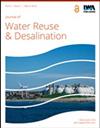天然菱铁矿活化过硫酸盐用于水消毒的特性及机理
IF 2.3
Q2 Environmental Science
引用次数: 9
摘要
本研究采用低成本的菱铁矿活化过硫酸氢盐(PDS, S2O82-)灭活粪肠球菌,研究菱铁矿/PDS的灭活特性及机制。结果表明,在pH为3时,菱铁矿/PDS对粪肠球菌具有较好的灭活效果。灭菌效果随菱铁矿用量、PDS浓度和温度的增加而增加。随着初始细菌浓度的增加,失活率降低。无机离子和天然有机物(NOM)均能抑制该技术的失活效果,抑制强度为:NOM > HCO3−> NO3−。自由基淬火试验表明,在菱铁矿/PDS工艺灭菌过程中,HO•是主要的氧化物质。此外,主要的消毒机制是高活性氧破坏细菌的细胞壁,释放细胞中的有机化合物。菱铁矿重复利用4次后,对其进行简单洗涤,可回收菱铁矿/PDS中粪肠球菌去除率的近80%,说明菱铁矿具有回收利用的潜力。本文章由计算机程序翻译,如有差异,请以英文原文为准。
Characteristics and mechanism of persulfate activated by natural siderite for water disinfection
In this study, low-cost siderite was used to activate peroxydisulfate (PDS, S2O82-)-inactivated Enterococcus faecalis to study the inactivation characteristics and mechanism of siderite/PDS. The results showed that the siderite/PDS had a better inactivation effect on Enterococcus faecalis at pH 3. The sterilization effect increases with the increase of siderite dosage, PDS concentration and temperature. The inactivation rate is decreased with the increase of initial bacterial concentration. Inorganic ions and natural organic matter (NOM) can inhibit the inactivation effect of this technology, and the inhibition intensity is NOM > HCO3− > NO3−. The free radical quenching test shows that HO• is the main oxidizing substance in the sterilization process of siderite/PDS technology. In addition, the main disinfection mechanism is highly reactive oxygen species destroying the cell wall of bacteria and releasing organic compounds in cells. After siderite was reused for four times, simply washing siderite would recover almost 80% of the removal of Enterococcus faecalis in siderite/PDS, indicating that siderite has the potential of recycling.
求助全文
通过发布文献求助,成功后即可免费获取论文全文。
去求助
来源期刊

Journal of Water Reuse and Desalination
ENGINEERING, ENVIRONMENTAL-WATER RESOURCES
CiteScore
4.30
自引率
0.00%
发文量
23
审稿时长
16 weeks
期刊介绍:
Journal of Water Reuse and Desalination publishes refereed review articles, theoretical and experimental research papers, new findings and issues of unplanned and planned reuse. The journal welcomes contributions from developing and developed countries.
 求助内容:
求助内容: 应助结果提醒方式:
应助结果提醒方式:


